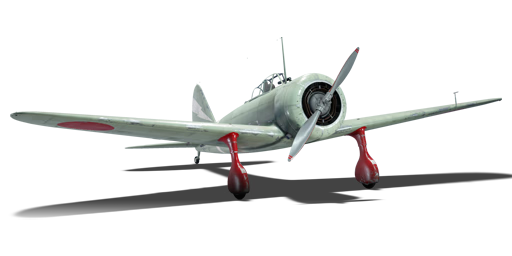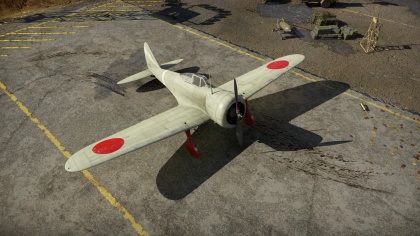Ki-27 otsu
Contents
| This page is about the Japanese fighter Ki-27 otsu. For Chinese version, see Ki-27 otsu (China). |
Description
The Ki-27 otsu is a rank Japanese fighter
with a battle rating of (AB), (RB), and (SB). It was introduced in Update 1.43.
The Allied reporting name for this plane was "Nate"; however, it was also called "Abdul" in the "China Burma India" theater by many post-war sources.
The Ki-27 is a front-line fighter for interwar / pre-WW2 historical engagements such as the Battles of Khalkin Gol. In most maps, the Ki-27 will distinguish itself as a low-level dog-fighter; its performance below 1,000 m is superb and it can manoeuvre away from nearly any other comparable fighter. Like the Ki-10 series before it, the Ki-27 otsu suffers from its poor armament (twin 7.7 mm Type 89s) and weak armour, which means it makes for a poor interceptor despite its high speed, but the Ki-27 makes an excellent escort for friendly bombers and flying boats. Providing cover for their allied bombers is a top priority for the Ki-27 pilots.
Like its Ki-10 predecessor, the Ki-27 relies on its manoeuvrability for its protection. Turn-Fighting, therefore, is vital for a Ki-27 pilot. Avoid diving on opponents, due to the Ki-27's fuel feed issues, and focus on scaring enemy pursuers away from bombers rather than chasing a kill. A lone Ki-27 is easy prey for allied energy fighters. Like most Japanese fighters, engaging an enemy head-on is not recommended. If fighting an enemy "energy Fighter" head-on, a good strategy is to turn away (usually a slight turn as you'll want him to miss you, but also pass you), and hope that he turns to follow.
Like the comparable A5M4, the Ki-27's carburettor engine suffers from fuel feed issues in negative G manoeuvres, like diving. Nosing down will cause the engine to choke out. Positive G manoeuvres like the Split-S are preferred. This issue will allow enemies to out dive the Ki-27, so engaging at low altitudes is preferred.
Additionally, the Ki-27 runs hot and will overheat at 100% throttle on all but the coldest maps. To cool off, ease the throttle back to 40% or 50% and, if possible, try to gain altitude. If the engine overheats during a dog fight, try to break off if the opportunity presents itself. No pilot can outmanoeuvre an overheated engine.
General info
Flight performance
| Characteristics | Max Speed (km/h at 3,500 m) |
Max altitude (metres) |
Turn time (seconds) |
Rate of climb (metres/second) |
Take-off run (metres) | |||
|---|---|---|---|---|---|---|---|---|
| AB | RB | AB | RB | AB | RB | |||
| Stock | 476 | 465 | 10.2 | 10.6 | 8.5 | 8.5 | 180 | |
| Upgraded | 517 | 495 | 9.8 | 10.0 | 18.6 | 12.8 | ||
Details
| Features | ||||
|---|---|---|---|---|
| Combat flaps | Take-off flaps | Landing flaps | Air brakes | Arrestor gear |
| X | X | ✓ | X | X |
| Limits | ||||||
|---|---|---|---|---|---|---|
| Wings (km/h) | Gear (km/h) | Flaps (km/h) | Max Static G | |||
| Combat | Take-off | Landing | + | - | ||
| N/A | N/A | 220 | ~10 | ~7 | ||
| Optimal velocities (km/h) | |||
|---|---|---|---|
| Ailerons | Rudder | Elevators | Radiator |
| < 350 | < 350 | < 350 | > 296 |
| Compressor (RB/SB) | ||
|---|---|---|
| Setting 1 | ||
| Optimal altitude | 100% Engine power | WEP Engine power |
| 3,300 m | 705 hp | 846 hp |
Survivability and armour
The Ki-27 does not have any armour, so your great turn rate is the only real defence. The fuel tanks aren't self-sealing either, which only strengthens the need to use your great turn rate. There is one fuel tank above and behind the oil cooling system; the rest are in the wings, with 2 in each wing.
Armaments
Offensive armament
The Ki-27 otsu is armed with:
- 2 x 7.7 mm Type 89 machine guns, nose-mounted (500 rpg = 1,000 total)
Usage in battles
A superior dogfighter for turn-fighting, the Ki-27 is the first plane to begin showing the features typical of the Japanese "Zero" but with none of the bite. Its speed and manoeuvrability are plagued by engine problems, with no armour and a standard armament.
Manual Engine Control
| MEC elements | ||||||
|---|---|---|---|---|---|---|
| Mixer | Pitch | Radiator | Supercharger | Turbocharger | ||
| Oil | Water | Type | ||||
| Controllable | Controllable Not auto controlled |
Controllable Not auto controlled |
Controllable Not auto controlled |
Separate | Not controllable 1 gear |
Not controllable |
Modules
| Tier | Flight performance | Survivability | Weaponry | |
|---|---|---|---|---|
| I | Fuselage repair | Radiator | Offensive 7 mm | |
| II | Compressor | Airframe | ||
| III | Wings repair | Engine | New 7 mm MGs | |
| IV | Engine injection | Cover | ||
- At this rank, the order of research is mainly personal preference, though the Ki-27 Otsu will benefit significantly from defensive and performance enhancing modifications.
Pros and cons
Pros:
- Great manoeuvrability, on par with biplanes
- Good stability in turns
- Good speed, for its tier
- Excellent climb, can reach above 20 m/s
Cons:
- Limited firepower
- Engine overheats rapidly on hot maps
- Engine chokes in negative G dives
- No armour
History
The Nakajima Ki-27 otsu began as the Ki-11, a competitor for the Kawasaki Ki-10 biplane. While faster and more modern than the Ki-10 biplane, the Ki-11 wasn't adopted because the Imperial Japanese Army valued manoeuvrability over speed. Nakajima continued development of the design before finalising the Ki-12, a modern monoplane with a liquid-cooled engine and retractable landing gear, but the Army denied it outright as too maintenance heavy for forward airbases in Manchuria and China. The redesigned plane instead featured a radial air-cooled engine, fixed landing gear and fully enclosed cockpit and received the designation Ki-27.
In 1936, the Ki-27 competed against the Kawasaki Ki-28 (a prototype design fated to never enter production) and the Mitsubishi Ki-33 (a de-navalised A5M). While the Ki-33 outperformed the Ki-27 in most regards, the Imperial Japanese Army was loath to adopt a "navy fighter", and approved the Ki-27 with minor modifications. The Ki-27 entered service as the Army Type 97 Fighter.
While the Ki-10 would not be finally phased out from front line service until 1942, by 1940, the Ki-27 was the primary army fighter on the front lines. It was unmatched by any plane in the Chinese air force inventory, and outperformed the Soviet I-15 and I-16 fighters in the Battles of Khalkhin Gol, with some pilots scoring 11 kills against Soviet planes in a single day. Against Chinese Curtiss P-36 Hawks, veteran Ki-27 pilots achieved similar, but not as impressive kill rates.
Over China, the Ki-27 was unmatched until the deployment of the P-40 Warhawks with the American Volunteer Group. After America's entry into the war, the Ki-27 also fared poorly against the US Navy's F2A Brewster Buffalo and F4F Wildcat and was removed from most front line service within the first months of the war, replaced by the much-improved Ki-43. However, it remained a front line fighter in Thai service, where the Ki-27 scored recorded kills against P-51s and at least one P-38.
Because of their high production numbers and relatively few losses, Ki-27 would see a renewed role late in the war as Kamikaze planes.
Media
Excellent additions to the article would be video guides, screenshots from the game, and photos.
See also
Links to the articles on the War Thunder Wiki that you think will be useful for the reader, for example:
- reference to the series of the aircraft;
- links to approximate analogues of other nations and research trees.
External links
| Nakajima Aircraft Company (中島飛行機株式会社 ) | |
|---|---|
| Fighters | Ki-27 otsu · Ki-27 otsu Tachiarai |
| Ki-43-I · Ki-43-II · Ki-43-III otsu | |
| Ki-44-I · Ki-44-I 34 · Ki-44-II otsu · Ki-44-II hei | |
| Ki-84 ko · Ki-84 otsu · Ki-84 hei | |
| Ki-87 | |
| Hydroplanes | A6M2-N* |
| Interceptors | J1N1 · J5N1 |
| Bombers | B5N2 |
| B6N1 Model 11 · B6N2 Model 12 · B6N2a Model 12Ko | |
| G5N1 · G8N1 | |
| Ki-49-I · Ki-49-IIa · Ki-49-IIb · Ki-49-IIb/L | |
| Recon | E8N2 |
| Jet Fighters | Kikka |
| Captured | ␗Ki-27 otsu · ▃Ki-43-II · ␗Ki-43-III ko · ␗Ki-44-II hei · ␗Ki-84 ko |
| *Refit of the Mitsubishi A6M2 mod. 11 | |
| See also | Fuji Heavy Industries (1957-2017) |
| Japan fighters | |
|---|---|
| Navy | |
| Carrier-based fighter | |
| A5M | A5M4 · Hagiri's A5M4 |
| A6M | A6M2 mod. 11 · A6M2 · A6M3 · A6M3 mod. 22 · A6M3 mod. 22Ko · A6M5 · A6M5 Ko · A6M5 otsu · A6M5 Hei · A6M6c |
| A7He | A7He1* |
| A7M | A7M1 (NK9H) · A7M2 |
| Land-based Fighter | |
| J2M | J2M2 · J2M3 · J2M4 Kai · J2M5 · J2M5 (30 mm) |
| J6K | J6K1 |
| J7W | J7W1 |
| N1K-J | N1K1-Ja · N1K2-J · N1K2-Ja |
| Fighter seaplane | |
| N1K | N1K1 |
| A6M-N | A6M2-N |
| Army | |
| Ki-10 | Ki-10-I · Ki-10-I C · Ki-10-II · Ki-10-II C |
| Ki-27 | Ki-27 otsu · Ki-27 otsu Tachiarai |
| Ki-43 | Ki-43-I · Ki-43-II · Ki-43-III otsu |
| Ki-44 | Ki-44-I · Ki-44-I 34 · Ki-44-II otsu · Ki-44-II hei |
| Ki-61 | Ki-61-I ko · Ki-61-I otsu · Ki-61-I hei · Tada's Ki-61-I hei · Ki-61-I tei · Ki-61-II Otsu Kai |
| Ki-84 | Ki-84 ko · Ki-84 otsu · Ki-84 hei |
| Ki-87 | Ki-87 |
| Ki-94 | Ki-94-II |
| Ki-100 | Ki-100 · Ki-100-II |
| Other countries | ▅F4U-1A · ▅P-51C-11-NT · ▅Bf 109 E-7 · ▅Fw 190 A-5 |
| *Imported designation of the He 112 (A6M was in development - A7M would take A7 designation after the cancelation of the A7He) | |





